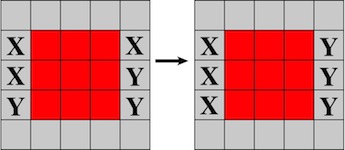Solution can work pretty much exactly the same as for the Rubik 4x4x4 solution that reduces solving to that of solving a Rubik 3x3x3; which we refer to here:
Phase 1: Match up the centers.Like the Rubik 4x4x4 solution, the same simple sequence can be used over and over to match up the center 3x3 regions. A little more organization for this process helps. Do the yellow face first, turn the cube over and do the other faces one at a time. For all but the last face, first make a column of three that passes through the center, and then for the other two columns, assemble a column of three in an adjacent unsolved face and then add it in (using the same simple sequence). The last face may end up solved after solving the second to last face, but if not and it looks like a complicated situation (e.g., just two squares exchanged between the two faces), don't worry, just perssit with the same simple sequence in different ways until you get them solved. You will likely have to mix up the second to last face as yo do this, and it may be helpful to make use of the variation where you twist the middle row along with the outer two.Phase 2: Match up the edges.Like the Rubix 4x4x4 solution, the same simple sequence can be used over and over to pair edge pieces, except now, first pair two and then pair them with the third piece. When down to the last two to be solved, the same final sequence for the last pair cane be used when the two edges are configured to look like this (where the X's are correct but the middle Y may be flipped):Phase 3: Solve like a Rubik's 3x3 cube. Solve as you would for a standard Rubik's 3x3x3 cube (the edge pairs and the center 3x3 squares stay together as you do the standard U, D, L, R, F, B moves). At this point if you are lucky, the cube is completely solved!
Solve as you would for a standard Rubik's 3x3x3 cube (the edge pairs and the center 3x3 squares stay together as you do the standard U, D, L, R, F, B moves). At this point if you are lucky, the cube is completely solved!
However, although the PLL parity of the Rubik 4x4x4 cube is no longer possible, OLL parity may have to be fixed. The single flipped edge triple will have a correctly oriented center piece and the two pieces to its left and right flipped. In fact, due to the presence of the correct center in a flipped triple, the presence of OLL parity becomes apparent at the end of Phase 2. For example, when referring to the figure above, either the center Y piece is flipped on the left (and things work out ok) or it is not and ends up flipped on the right.
Meffert's Page, from: http://www.mefferts.com/puzzles/profsol.html
Jaap's Page, from: http://www.jaapsch.net/puzzles/cube5.htm
McFarren's Page, from: http://www.geocities.com/abcmcfarren/math/rp/RubPro1.htm
Monroe's Page, from: http://www.geocities.com/alchemistmatt/cube/5by5cube.html
Instructables Page, from: http://www.instructables.com/id/How-to-solve-a-5x5-Rubiks-Professor-cube
Ruwix Page, from: https://ruwix.com/twisty-puzzles/5x5x5-rubiks-cube-professors-cube
Simply Rubik Page, from: http://rubik.rthost.org/5x5x5_edges.htm
wikiHow Page, from: https://www.wikihow.com/Solve-a-5x5x5-Rubik%27s-Cube
Wikipedia Page, from: http://en.wikipedia.org/wiki/Professor's_Cube
Krell Patent, from: www.uspto.gov - patent no. 4,600,199
Li Patent, from: www.uspto.gov - patent no. 6,129,356
Verdes Patent Application, from: www.uspto.gov - patent application 2007/0057455